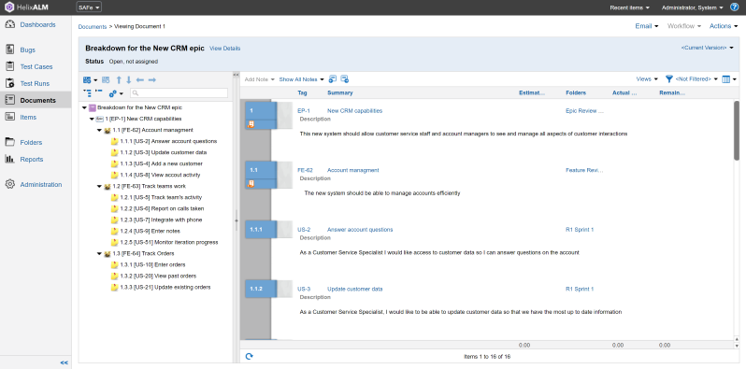
In any industry, designing and creating new products requires knowledge of what exactly the product’s purpose and intended capabilities are. Without this knowledge, product developers would only have a vague and easily misinterpreted idea of what the product they are working on is expected to accomplish. For this reason, product requirements documents, or PRDs, fulfill a vital role in product development for any type of product.
Product requirements documentation details what specifically a product needs to be able to do, when it is meant to be used, why it is needed, and who is intended to use it. By making proper use of product requirements documents, a development team can make sure that a product turns out the way the company envisioned it.
Why are Product Requirements Documents Needed?
Product requirements documents provide a way to get everyone on the same page regarding a project, ensuring they understand what the product is supposed to be and what they need to do to build it. More specifically, such documents give the product development team a clear idea of what needs to be included in the product design, what criteria and standards the product has to meet, and how much time they will likely need to develop it. This enables them to more effectively plan out their strategy for making the product and coordinate when performing their tasks.
In addition, these documents allow new developers to quickly understand what the product consists of and how to help. PRDs also define a project’s scope, setting limits on what the product will include and clarifying what it will not. This ensures that the team remains on task and does not lose sight of its goal or the product’s purpose. Finally, product requirements documents set the groundwork for other documents, such as functional specifications.
These subsequent documents build on the information and design ideas provided by the PRD to further flesh out the product. Therefore, PRDs lay the groundwork for other documents to follow, aiding the progression of the development process as a whole.
The Components of Product Requirements Documents
The following sections describe the main components of product requirements documents. However, keep in mind that PRDs for a specific product or industry could also include other sections.
Capabilities
This section refers to the features of a product and what it is capable of doing. For instance, a refrigerator’s features and capabilities would include storing food and keeping it cold, using energy efficiently, etc. Each of a product’s features and capabilities is meant to help that product fulfill its purpose. Therefore, it is absolutely essential for the development team to know the specific capabilities a product needs to have. The plans for the features and capabilities of the product should take into account the information in the other sections. This section should also lay out what should not be included in the product.
Intended Users
The intended users for a product are the people who it is designed to be used by. This most often consists of people belonging to a particular occupation whose duties the project would help with. If the development team knows who the intended users are, they can get a better idea of how the product would be incorporated into those users’ duties. With this information, they can then design the product to be more efficiently and easily utilized by those users.
Purpose
This section describes the problem the product is meant to solve. This purpose forms the basis for the product’s features and capabilities, which are designed to achieve the goal or solve the problem in question. By knowing the product’s purpose, developers can better determine what particular features to include in it. In addition, the purpose determines who is meant to use the product, and the situations it should be used in. In essence, defining a product’s purpose acts as the central first step in making the PRD.
Use Cases
Use cases are examples of the specific situations where a product’s features should be used and how to use them. For example, a use case for a new piece of construction equipment could involve performing a certain task to help construct a building. This helps to create a clearer idea of what the product’s features should be and how they would be used. In a PRD, the description of each feature or capability should be accompanied by a use case for that feature.
Criteria and Success Metrics
Criteria refer to the standards a product’s functionality, use, and performance must meet for it to be released. A product must not simply work, it must work well enough to meet or surpass the expectations the stakeholders and product manager set for it. More specifically, the criteria for a product include its effectiveness, ease of use, and functionality.
Setting these criteria helps to ensure that the product is of the highest quality possible and that its features actually fulfill its purpose by the time of release. Meanwhile, success metrics are factors used to measure how successful a product is after its release. If the developers know the success metrics for a product, they can determine how to make it as successful as possible.
Assumptions and Dependencies
Assumptions and dependencies are outside factors that are necessary to ensure the product’s functionality, but whose presence cannot be guaranteed. Instead, these factors must be assumed or depended on to be present when designing the product. For instance, a computer game would require both a computer to play it on the software necessary to run it. The PRD should list these factors so the development team can design the product to work with said factors.
Development Timeline
The development timeline for a product includes the approximate amount of time for the product’s development to be completed, its estimated release date, and a series of major stages, or “milestones”, that the development cycle should go through.
The development team uses this timeline as a rough schedule for their work. It helps them to decide how long they should spend on each step, and determine how much time they have. They should do their best to have the product completed by the planned release date, though they should not rush the development process to meet that deadline if the product’s quality or functionality would be affected.

Who Writes Product Requirements Documents?
In general, a product manager writes product requirements documents. However, a technical writer might be assigned to write the PRD instead, who has a more specialized documentation creation skillset. One of these two considers the product idea that the company gives them, and develops the PRD around that idea.
With this accomplished, the product manager or documentation writer shows the PRD to the stakeholders to ensure they are all on the same page for the project. Afterward, they pass on the document to the rest of the development team, who use it to design the product. Creating the document itself involves a number of steps and factors, which will be discussed in the next section.
How to Make Product Requirements Documents
When making product requirements documents, a product manager or documentation writer starts by considering what the exact purpose of the product and then determining what features would best achieve that purpose, before clearly stating the purpose in the document. Afterward, they should describe all of the features and capabilities the product will need, along with use cases for each. They then explain who the intended users are, followed by the criteria the product must meet to be released. Then, they should lay out the development timeline, before finally explaining the assumptions and dependencies that will affect the product.
While creating the PRD, the writer should also consult the stakeholders – including investors, developers, subject matter experts, and customers – to get their thoughts. This will allow the writer to get valuable feedback and insight, such as ideas for a viable design plan. In addition, a PRD should be updated continuously throughout the development process to incorporate new ideas or changes to the plans for the product. Finally, the PRD should be made easily and constantly accessible for all members of the development team.
What a PRD Should Not Include
In order to make an effective and helpful PRD, it is also necessary to know what not to write in it. First, while product requirements documents explain what a product is supposed to be capable of doing, it does not necessarily explain the technical details of how the product performs a task. It also does not describe how the features of a product should be implemented. Instead, such information is mostly described in other requirements documents.
PRDs and Other Requirements Documents
Product requirements documents are not the only kind of requirements document. Other kinds of requirements documents include marketing requirements documents, software requirements documents, business requirements documents, and technical requirements documents. Each of these documents provides information on a different aspect of the development process for a product.
Furthermore, several requirements documents, such as technical requirements documents, draw on the information in the PRD or use it as a starting point, much like the previously-mentioned functional specifications do. In this way, product requirements documents work with the other requirements documents to create a unified, complete picture of what needs to be done when making a product.
Conclusion
The importance of product requirements documents in the development cycle for a product cannot be overstated. They help ensure that a company gets the product it asked for, and that the product works as it should. With a good PRD, a development team has a reason to be much more confident in their chances of success.
How Can EDC Help?
Whether you need a single technical writer for a brief project or a team of consultants to produce a complete line of documentation, the quality of our work is guaranteed for you. Our clients work closely with an Engagement Manager from one of our 30 local offices for the entire length of your project at no additional cost. Contact us at (800) 221-0093 or sales@edc.us to get started.
Written by Noah Grayson

